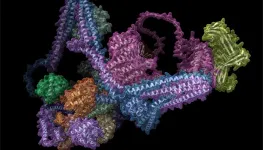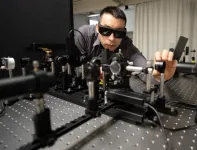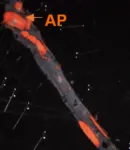(Press-News.org) CAMBRIDGE, MA -- Genomic studies of cancer patients have revealed thousands of mutations linked to tumor development. However, for the vast majority of those mutations, researchers are unsure of how they contribute to cancer because there’s no easy way to study them in animal models.
In an advance that could help scientists make a dent in that long list of unexplored mutations, MIT researchers have developed a way to easily engineer specific cancer-linked mutations into mouse models.
Using this technique, which is based on CRISPR genome-editing technology, the researchers have created models of several different mutations of the cancer-causing gene Kras, in different organs. They believe this technique could also be used for nearly any other type of cancer mutation that has been identified.
Such models could help researchers identify and test new drugs that target these mutations.
“This is a remarkably powerful tool for examining the effects of essentially any mutation of interest in an intact animal, and in a fraction of the time required for earlier methods,” says Tyler Jacks, the David H. Koch Professor of Biology, a member of the Koch Institute for Integrative Cancer Research at MIT, and one of the senior authors of the new study.
Francisco Sánchez-Rivera, an assistant professor of biology at MIT and member of the Koch Institute, and David Liu, a professor in the Harvard University Department of Chemistry and Chemical Biology and a core institute member of the Broad Institute, are also senior authors of the study, which appears today in Nature Biotechnology.
Zack Ely PhD ’22, a former MIT graduate student who is now a visiting scientist at MIT, and MIT graduate student Nicolas Mathey-Andrews are the lead authors of the paper.
Faster editing
Testing cancer drugs in mouse models is an important step in determining whether they are safe and effective enough to go into human clinical trials. Over the past 20 years, researchers have used genetic engineering to create mouse models by deleting tumor suppressor genes or activating cancer-promoting genes. However, this approach is labor-intensive and requires several months or even years to produce and analyze mice with a single cancer-linked mutation.
“A graduate student can build a whole PhD around building a model for one mutation,” Ely says. “With traditional models, it would take the field decades to catch up to all of the mutations we've discovered with the Cancer Genome Atlas.”
In the mid-2010s, researchers began exploring the possibility of using the CRISPR genome-editing system to make cancerous mutations more easily. Some of this work occurred in Jacks’ lab, where Sánchez-Rivera (then an MIT graduate student) and his colleagues showed that they could use CRISPR to quickly and easily knock out genes that are often lost in tumors. However, while this approach makes it easy to knock out genes, it doesn’t lend itself to inserting new mutations into a gene because it relies on the cell’s DNA repair mechanisms, which tend to introduce errors.
Inspired by research from Liu’s lab at the Broad Institute, the MIT team wanted to come up with a way to perform more precise gene-editing that would allow them to make very targeted mutations to either oncogenes (genes that drive cancer) or tumor suppressors.
In 2019, Liu and colleagues reported a new version of CRISPR genome-editing called prime editing. Unlike the original version of CRISPR, which uses an enzyme called Cas9 to create double-stranded breaks in DNA, prime editing uses a modified enzyme called Cas9 nickase, which is fused to another enzyme called reverse transcriptase. This fusion enzyme cuts only one strand of the DNA helix, which avoids introducing double-stranded DNA breaks that can lead to errors when the cell repairs the DNA.
The MIT researchers designed their new mouse models by engineering the gene for the prime editor enzyme into the germline cells of the mice, which means that it will be present in every cell of the organism. The encoded prime editor enzyme allows cells to copy an RNA sequence into DNA that is incorporated into the genome. However, the prime editor gene remains silent until activated by the delivery of a specific protein called Cre recombinase.
Since the prime editing system is installed in the mouse genome, researchers can initiate tumor growth by injecting Cre recombinase into the tissue where they want a cancer mutation to be expressed, along with a guide RNA that directs Cas9 nickase to make a specific edit in the cells’ genome. The RNA guide can be designed to induce single DNA base substitutions, deletions, or additions in a specified gene, allowing the researchers to create any cancer mutation they wish.
Modeling mutations
To demonstrate the potential of this technique, the researchers engineered several different mutations into the Kras gene, which drives about 30 percent of all human cancers, including nearly all pancreatic adenocarcinomas. However, not all Kras mutations are identical. Many Kras mutations occur at a location known as G12, where the amino acid glycine is found, and depending on the mutation, this glycine can be converted into one of several different amino acids.
The researchers developed models of four different types of Kras mutations found in lung cancer: G12C, G12D, G12R, and G12A. To their surprise, they found that the tumors generated in each of these models had very different traits. For example, G12R mutations produced large, aggressive lung tumors, while G12A tumors were smaller and progressed more slowly.
Learning more about how these mutations affect tumor development differently could help researchers develop drugs that target each of the different mutations. Currently, there are only two FDA-approved drugs that target Kras mutations, and they are both specific to the G12C mutation, which accounts for about 30 percent of the Kras mutations seen in lung cancer.
The researchers also used their technique to create pancreatic organoids with several different types of mutations in the tumor suppressor gene p53, and they are now developing mouse models of these mutations. They are also working on generating models of additional Kras mutations, along with other mutations that help to confer resistance to Kras inhibitors.
“One thing that we're excited about is looking at combinations of mutations including Kras mutations that drives tumorigenesis, along with resistance associated mutations,” Mathey-Andrews says. “We hope that will give us a handle on not just whether the mutation causes resistance, but what does a resistant tumor look like?”
The researchers have made mice with the prime editing system engineered into their genome available through a repository at the Jackson Laboratory, and they hope that other labs will begin to use this technique for their own studies of cancer mutations.
###
The research was funded by the Ludwig Center at MIT, the National Cancer Institute, a Howard Hughes Medical Institute Hanna Grey Fellowship, the V Foundation for Cancer Research, a Koch Institute Frontier Award, the MIT Research Support Committee, a Helen Hay Whitney Postdoctoral Fellowship, the David H. Koch Graduate Fellowship Fund, the National Institutes of Health, and the Lustgarten Foundation for Pancreatic Cancer Research.
Other authors of the paper include Santiago Naranjo, Samuel Gould, Kim Mercer, Gregory Newby, Christina Cabana, William Rideout, Grissel Cervantes Jaramillo, Jennifer Khirallah, Katie Holland, Peyton Randolph, William Freed-Pastor, Jessie Davis, Zachary Kulstad, Peter Westcott, Lin Lin, Andrew Anzalone, Brendan Horton, Nimisha Pattada, Sean-Luc Shanahan, Zhongfeng Ye, Stefani Spranger, and Qiaobing Xu.
END
Gene-editing technique could speed up study of cancer mutations
With the new method, scientists can explore many cancer mutations whose roles are unknown, helping them develop new drugs that target those mutations
2023-05-11
ELSE PRESS RELEASES FROM THIS DATE:
HudsonAlpha Institute for Biotechnology wins $1 million NSF Engines Development Award
2023-05-11
[HUNTSVILLE, ALABAMA] May 11, 2023 – HudsonAlpha Institute for Biotechnology, along with several regional collaborators, was awarded $1 million from the US National Science Foundation's Regional Innovation Engines, or NSF Engines, program. They are among the more than 40 unique teams to receive one of the first-ever NSF Engines Development Awards, which aim to help partners collaborate and create economic, societal, and technological opportunities for their regions.
The funded project, entitled “Advancing carbon-neutral crop technologies to develop sustainable consumer goods (AL, GA, NC, TN)” (“Greening the Southeast” ...
AI helps map the postal workers in cells
2023-05-11
University of Queensland researchers have used artificial intelligence to build a 3D map of key cell components to better understand dementia and infectious diseases including COVID-19.
Professor Brett Collins from UQ’s Institute for Molecular Bioscience and Professor Pete Cullen from the University of Bristol led a team that modelled the 16 subunit Commander complex, a bundle of proteins that act as ‘postal workers’ in cells.
“Just as the postal system has processes to transport ...
Artificial intelligence could improve heart attack diagnosis to reduce pressure on emergency departments
2023-05-11
An algorithm developed using artificial intelligence could soon be used by doctors to diagnose heart attacks with better speed and accuracy than ever before, according to new research from the University of Edinburgh, funded by the British Heart Foundation and the National Institute for Health and Care Research, and published today in Nature Medicine [1].
The effectiveness of the algorithm, named CoDE-ACS [2], was tested on 10,286 patients in six countries around the world. Researchers found that, compared to current testing methods, CoDE-ACS was able to rule ...
Spacemarkers novel AI method identifies locations, interactions among genes in and around tumors
2023-05-11
FOR IMMEDIATE RELEASE
SpaceMarkers, a new machine learning software developed by researchers at the Johns Hopkins Convergence Institute and the Johns Hopkins Kimmel Cancer Center, can identify molecular interactions among distinct types of cells in and around a tumor.
SpaceMarkers harnesses the information available through spatial transcriptomics — a cutting edge technology advancing the ability to measure gene expression in tissue samples based on their location in cells. Understanding the molecular profile of individual cells and the impact of intercellular interactions in the tumor microenvironment (cells ...
Obstructive sleep apnea associated with increased risks for long COVID
2023-05-11
Obstructive sleep apnea associated with increased risks for long COVID
Study suggests adults with both the sleep disorder and COVID may benefit from clinical monitoring
Among people who have had COVID-19, adults with obstructive sleep apnea were more likely to experience long-term symptoms suggestive of long COVID than those without the sleep disorder, according to a large study supported by the National Institutes of Health (NIH). In fact, multiple analyses of electronic health records (EHR) identified adults with sleep apnea may have up to a 75% higher risk ...
If one eye does not work, hearing goes at throttle up
2023-05-11
The senses represent our gates to receive information from the environment, but not all of them are always available for everyone, as in the case of blind or deaf people. Researchers know today quite well that the brain has the critical ability to adapt to different sensory experiences and, in some ways, to “compensate” for the lack of one sense or the other.
In a recent study, a group of researchers from the IMT School for Advanced Studies Lucca (Italy), in collaboration with a group from the University of Ulm (Germany), ...
New lens analysis approach could improve treatments for nearsightedness
2023-05-11
New lens analysis approach could improve treatments for nearsightedness
Instrumentation recreates properties of the myopic eye to test lenses that prevent visual decline
WASHINGTON — Researchers have developed new instruments for rigorously quantifying and comparing the light focusing properties of specialized eyeglass lenses that are used to slow the progression of myopia, or nearsightedness. The information gained with this new approach could help inform future lens designs that are even more effective at preventing visual decline.
Nearsightedness is on the rise around the globe, especially among children. If current trends continue, ...
Developing an AI tool to check ARRIVE compliance
2023-05-11
The freely available compliance checker will use natural language processing to automatically assess scientific manuscripts for the information in the ARRIVE Essential 10, a checklist of the most important details to include in any publication describing animal research.
A major factor influencing the reliability and reproducibility of animal experiments is how transparently they are reported. The ARRIVE guidelines help researchers improve the reporting of animal studies by clearly laying out the information that should be included in a manuscript. Reporting animal experiments in line with the ARRIVE guidelines is a requirement ...
Louisiana Cancer Research Center’s “Promising Practices Conference” seeks public and community involvement to help reduce cancer rates in Louisiana
2023-05-11
The Louisiana Cancer Research Center (LCRC) is stepping up its statewide efforts to reduce the state’s extraordinarily high cancer rates by enlisting the help of the public and communities. The LCRC’s newly established Office of Community Outreach and Engagement (OCOE) is convening an all-day “Promising Practices Conference” on Friday, June 2 at Louisiana Tech University and online to highlight the resources and assistance that are available to support better health and wellness throughout Louisiana and strategize on ways to overcome challenges. There is no charge to attend the conference, which is presented by the LCRC in collaboration with ...
High-fat diet ‘turns up the thermostat’ on atherosclerosis
2023-05-11
In a recent study, researchers determined that derivatives of natural emulsifiers such as phospholipids found in high-fat, high-cholesterol diets can promote atherosclerosis via gut bacteria interactions with the immune system. This study could pave the way for targeted interventions for individuals who are at risk for developing heart disease.
Obesity and a high-cholesterol, high-fat diet are both well-established risk factors for atherosclerosis. In fact, obese individuals are two and a half times more likely to develop heart disease. ...
LAST 30 PRESS RELEASES:
Researchers observe gas outflow driven by a jet from an active galactic nucleus
Pitt student finds familiar structure just 2 billion years after the Big Bang
Evidence of cross-regional marine plastic pollution in green sea turtles
Patients with clonal hematopoiesis have increased heart disease risk following cancer treatment
Stem cell therapy for stroke shows how cells find their way in the brain
Environment: Up to 4,700 tonnes of litter flows down the Rhine each year
Maternal vaccine receipt and infant hospital and emergency visits for influenza and pertussis
Interim safety of RSVpreF vaccination during pregnancy
Stem cell engineering breakthrough paves way for next-generation living drugs
California grants $7.4 million to advance gene-edited stem cell therapy for Friedreich’s ataxia
Victoria’s Secret grant backs cutting-edge ovarian cancer research
Research paves the way for safer colonoscopy bowel prep for people with compromised gut health
JMIR Publications and Sweden's National Library announce renewal and expansion of flat-fee unlimited open access partnership for 2026
A new 3D-printed solar cell that’s transparent and color-tunable
IV iron is the cost-effective treatment for women with iron deficiency anemia and heavy menstrual bleeding
Doing good pays off: Environmentally and socially responsible companies drive value and market efficiency
City of Hope and Cellares to automate manufacturing of solid tumor CAR T cell therapy
Short-circuiting pancreatic cancer
Groundbreaking mapping: how many ghost particles all the Milky Way’s stars send towards Earth
JBNU researchers propose hierarchical porous copper nanosheet-based triboelectric nanogenerators
A high-protein diet can defeat cholera infection
A more accurate way of calculating the value of a healthy year of life
What causes some people’s gut microbes to produce high alcohol levels?
Global study reveals widespread burning of plastic for heating and cooking
MIT study shows pills that communicate from the stomach could improve medication adherence
Searching for the centromere: diversity in pathways key for cell division
Behind nature’s blueprints
Researchers search for why some people’s gut microbes produce high alcohol levels
Researchers find promising new way to boost the immune response to cancer
Coffee as a staining agent substitute in electron microscopy
[Press-News.org] Gene-editing technique could speed up study of cancer mutationsWith the new method, scientists can explore many cancer mutations whose roles are unknown, helping them develop new drugs that target those mutations





